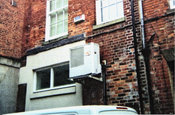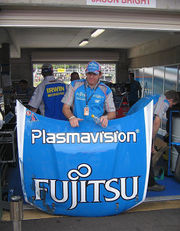Fujitsu
 |
|
| Type | Public (TYO: 6702) |
|---|---|
| Industry | Computer hardware Computer software IT services IT consulting |
| Founded | Kawasaki, Kanagawa, Japan (Incorporated 1935)[1] |
| Headquarters | Minato, Tokyo, Japan |
| Key people | Michiyoshi Mazuka (Chairman) Koichi Hironishi (Senior EVP, Services Business Group) Tatsuo Tomita (Senior EVP, Products Business Group) Richard Christou (President, Global Business Group)[2] |
| Products | See products listing |
| Revenue | |
| Operating income | |
| Net income | |
| Total assets | |
| Employees | 185,926 (June 2009)[4] |
| Website | www.fujitsu.com |
.jpg)
Fujitsu Limited (富士通株式会社 Fujitsū Kabushiki-gaisha) is a Japanese multinational computer hardware and IT services company headquartered in the Shiodome City Center complex in Minato, Tokyo.[5] Fujitsu's central focus is on providing IT-driven business solutions, but the company and its subsidiaries also offer a diversity of products and services in the areas of personal computing, telecommunications and advanced microelectronics.
With over 185,000 employees worldwide,[4] including subsidiaries and affiliates in 70 countries, Fujitsu is the world's third largest IT services provider [6] and the largest in Japan.
The old slogan "The possibilities are infinite" can be found below the company's logo on major advertisements and ties in with the small logo above the letters J and I of the word Fujitsu. This smaller logo (∞), represents the symbol for infinity. As of April 2010, Fujitsu is in the process of rolling out a new slogan focused on partnering with its customers and retiring the "possibilities are infinite" tagline. The new slogan is "Shaping tomorrow with you" [7] .
Contents |
History
[8] The company was established on June 20, 1935, under the name Fuji Tsūshinki Seizō (富士通信機製造, Fuji Telecommunications Equipment Manufacturing), a spinoff of the Fuji Electric Company, this in turn being a joint venture between the Furukawa Electric Company and German conglomerate Siemens founded in 1923. Despite its connections to the Furukawa zaibatsu, Fujitsu escaped the Allied occupation of Japan mostly unscathed.
In 1954, Fujitsu manufactured Japan's first computer, the FACOM 100, and in 1961 the transistorized FACOM 222. In 1967, the company's name was officially changed to the contraction Fujitsū (富士通).
In 1955, Fujitsu founded Kawasaki Frontale (川崎フロンターレ, Kawasaki Furontāre) as a Fujitsu soccer club. Kawasaki Frontale has now been a J. League football club since 1999.
In 1971, Fujitsu signed an OEM agreement with the Canadian company, Consolidated Computers Ltd (later Consolidated Computer Inc.) to distribute CCL's world leading data entry product, Key-Edit. Fujitsu joined both ICL who earlier began marketing Key-Edit in the British Commonwealth of countries as well as in both western and eastern Europe; and CCL's direct marketing staff in Canada, USA, London (UK) and Frankfurt. Mers Kutt, inventor of Key-Edit and founder of CCL, was the common thread that led to Fujitsu’s later association with ICL and Gene Amdahl.
In 1990, Fujitsu bought 80% of International Computers Limited (ICL), which ultimately became Fujitsu Services in 2002. Fujitsu Services' business is helping its customers realize the value of information technology through the application of consulting, systems integration and managed service contracts. It serves customers in the private and public sectors across Europe including retail, financial services and Government.
In July 1991, ICL (Fujitsu) acquired more than half of the Russian company KME-CS (Kazan Manufacturing Enterprise of Computer Systems, Kazan, Tatarstan, Russia). The agreement was signed between Peter Bonfield (President of ICL) and Mintimer Shaimiev (President of the Tatarstan Republic).
In 1993, Fujitsu entered into a joint manufacturing venture with AMD to merge flash memory operations. The jointly-produced flash memory product was named Spansion. As part of the merger deal, AMD contributed its flash memory group, Fab 25 in Texas, its R&D facilities and assembly plants in Thailand, Malaysia and China; Fujitsu provided its Flash memory business division and the Malaysian Fujitsu Microelectronics final assembly and test operations.[9]
From February 1989 until mid-1997, Fujitsu built the FM Towns PC variant. It started as a proprietary PC variant intended for multimedia applications and computer games, but later became more compatible with regular PCs. In 1993, the FM Towns Marty was released, a gaming console compatible with the FM Towns games.
Amdahl became a wholly owned subsidiary of Fujitsu in 1997 and with it the DMR consulting group, based in Canada.
In 1998, Fujitsu was headquartered in Nakahara-ku, Kawasaki, Kanagawa Prefecture and maintained an office in Chiyoda, Tokyo.[10]
The active partnership with Siemens AG was revived in 1999 in the form of Fujitsu Siemens Computers, which became one of Europe's largest IT hardware suppliers, and was owned 50/50 by Fujitsu and Siemens. However, on April 1, 2009, Fujitsu bought out Siemens' stake in the Fujitsu Siemens Computers joint venture for approximately EUR450m.[11] Fujitsu Siemens Computers became Fujitsu Technology Solutions from this date.[12]
Shiodome City Center, which became Fujitsu's headquarters, opened in 2003.[13]
In 1992, Fujitsu introduced the world's first 21-inch full-color plasma display. It was a hybrid, based upon the plasma display created at the University of Illinois at Urbana-Champaign and NHK STRL, achieving superior brightness. Many people will be familiar with Fujitsu through such consumer products - they are sold through a subsidiary joint venture company Fujitsu General, along with air conditioners.
On March 2, 2004, Fujitsu Computer Products of America lost a class action lawsuit over hard disk drives with defective chips and firmware.Fujitsu also signed a partner agreement with AlmanteQ Co (which are distributors of Fujitsu products in Libya. Libya being one of the most rapidly increasing economies in the world.
In October 2004, Fujitsu's Australian subsidiary bought the Australian arm of Atos Origin, a systems implementation company specializing in SAP.
On April 1, 2006, Fujitsu Software Corporation merged with Fujitsu Computer Systems Corporation.
In October 2007, Fujitsu launched its new $10 million facility in Noida, India.
In October 2007, Fujitsu's Australia and New Zealand subsidiary bought Infinity Solutions Ltd, a New Zealand IT hardware, services and consultancy company.
In January 2009, Fujitsu reached an agreement to sell its HDD business to Toshiba.[14] Transfer of the business is supposed to conclude at the end of the fiscal 1st quarter of 2009.[15]
Fujitsu businesses
Fujitsu Air conditioning

Fujitsu markets various Air conditioning units and humidity control solutions.[16]
Fujitsu Consulting
Fujitsu Consulting is the consulting and services arm of the Fujitsu group, providing information technology consulting, implementation and management services.
Fujitsu Consulting was founded in 1973 in Montreal, Canada under its original name "DMR" (an acronym of the three founder's names: Pierre Ducros, Serge Meilleur and Alain Roy). During the next decade, the company established a presence throughout Quebec and Canada, before extending its reach to international markets. For nearly thirty years, DMR Consulting grew to become an international consulting firm, changing its name to Fujitsu Consulting in 2002 after being acquired by Fujitsu Ltd.[17]
Computing products
Fujitsu markets personal computing, telecommunications and advanced microelectronics solutions.[18] Fujitsu was for a time one of the largest global PC vendors.
Product lines include:
ETERNUS, Fujitsu’s storage hardware and software infrastructure as part of the company’s Dynamic Infrastructures Portfolio. The word aeternus means "eternal" in Latin. Fujitsu adopted this name for the global storage brand to match the company’s concepts; of protecting customer assets forever and ensuring continuous business operation. The ETERNUS product lineup includes Disk Storage Systems, Tape Systems, Virtual Tape Appliances, SAN Switches, and Storage Management Software.
LIFEBOOK, AMILO Fujitsu's range of notebook computers and tablet PCs.
PRIMERGY, Fujitsu's server family including PRIMERGY Tower Servers, PRIMERGY Rack Servers, and PRIMERGY Blade Servers.
Fujitsu Laboratories Ltd.
Fujitsu Laboratories, Fujitsu's Research and Development division, has 1,300 employees and a capital of 5 Billion Yen. It is run by Tatsuo Tomita.[19]
Sponsorships

Fujitsu is a sponsor of Britek Motorsport, a team that races in the V8 Supercars touring car racing series.
Environmental record
Since 1993, Fujitsu has made Green PCs, such as FUTRO thin clients and ESPRIMO professional PCs. [20] It reports that all its notebook and tablet PCs released globally comply with the latest Energy Star standard. [21]
In Greenpeace's Guide to Greener Electronics of May 2010 the company ranks 15th out of 18 leading electronics manufacturers.[22] Greenpeace criticises Fujitsu for its slow progress in phasing out polyvinyl chloride (PVC) and brominated flame retardants (BFR). [23] Fujitsu is eliminating PVC from its products by the end of 2013 but has not committed to abolishing all BFRs. [24]
Australian spokesman
The key media figurehead for Fujitsu General in Australia is Mark Taylor, a now-retired former captain for the Australian Test Cricketing Side. He has done several advertisements for Fujitsu and has advertised such deals as Fujitsu Free Money and such air conditioning units as the Fujitsu Inverter System. Mark Taylor has been advertising Fujitsu General's products for a few years now and has become the Australian icon of the Company.[25]
See also
- @nifty
- FM Towns
- Fujitsu Computer Products of America
- Fujitsu Consulting
- Fujitsu Consulting India Limited
- Fujitsu Ladies
- Fujitsu Micro 16s
- Fujitsu Services
- Fujitsu Ten
- Fujitsu V8 Supercar Series
- Kawasaki Frontale
- List of computer system manufacturers
- List of Fujitsu products
- Lifebook
Notes
- ↑ "Fujitsu at a Glance". http://www.fujitsu.com/global/about/profile/info/. Retrieved July 13, 2009.
- ↑ "Corporate Executive Officers: FUJITSU". http://www.fujitsu.com/global/about/profile/management/corpofficers/index.html. Retrieved July 13, 2009.
- ↑ "FY 2008 Full-Year Financial Results", Fujitsu Limited website, April 30, 2009
- ↑ 4.0 4.1 "Fujitsu Data Book 2009". http://www.fujitsu.com/downloads/IR/library/databook/pdf/all.pdf. Retrieved December 1, 2009.
- ↑ "Japan All Contacts." Fujitsu. Retrieved on May 19, 2009.
- ↑ "Services Top 100, Edition 2009". Top 100 Research Foundation. http://www.servicestop100.org/it-services-companies-top-100.php.
- ↑ "FUJITSTU Japan". Fujitsu. http://jp.fujitsu.com/.
- ↑ Official Fuijtsu history
- ↑ By Alun Williams, PC Pro. “Spansion - AMD and Fujitsu brand their Flash memory.” July 13, 2003.
- ↑ "Company Profile." Fujitsu. January 19, 1998. Retrieved on May 19, 2009.
- ↑ Fujitsu.com
- ↑ TS.Fujitsu.com
- ↑ NihonSekkei.co.jp, Shiodome City Center Nihon Sekkei. Retrieved on May 19, 2009.
- ↑ Reuters (2009-01-14). "Toshiba and Fujitsu reach HDD deal: Nikkei". Press release. http://www.reuters.com/article/innovationNews/idUSTRE50D5LN20090114. Retrieved 2009-01-14.
- ↑ Xbitlabs (2009-02-17). "Toshiba Agrees to Acquire Fujitsu’s Hard Drive Business.". Press release. http://www.xbitlabs.com/news/storage/display/20090217060147_Toshiba_Agrees_to_Acquire_Fujitsu_s_Hard_Drive_Business.html. Retrieved 2009-02-17.
- ↑ [1]
- ↑ "Fujitsu - History". http://www.fujitsu.com/global/about/profile/history/. Retrieved 14 January 2010.
- ↑ List of major computer products
- ↑ http://jp.fujitsu.com/group/labs/en/about/
- ↑ "Corporate Social Responsibility - Environmental Care – About us - Fujitsu". Fujitsu. http://ts.fujitsu.com/aboutus/company_information/business_excellence/environmental_care/products.html. Retrieved 2010-08-12.
- ↑ "GIC – Service&Support/International Support". http://www.fmworld.net/globalpc/environment/energystar.html/. Retrieved 2010-08-12.
- ↑ "Guide to Greener Electronics - Greenpeace International". http://www.greenpeace.org/international/en/campaigns/toxics/electronics/Guide-to-Greener-Electronics/. Retrieved 2010-08-12.
- ↑ "Which companies are phasing out PVC and BFRs". http://www.greenpeace.org/international/en/campaigns/toxics/electronics/Guide-to-Greener-Electronics/which-companies-really-sell-gr/. Retrieved 2010-08-12.
- ↑ "GIC – Service&Support/International Support". Fujitsu. http://www.fmworld.net/globalpc/environment/index.html#chemical. Retrieved 2010-08-12.
- ↑ AFRbiz.com.au, Case Study: Promotion through personality and partnerships, 2005, Access date: September 24, 2007. Australian V8 Supercar drivers Jason Bright and Alan Gurr have also done some marketing/promotional work for Fujitsu and with Taylor due to his Fujitsu sponsored supercars
References
- Reuters.com, CEO Bilall Taghdi
External links
- Fujitsu.com, Fujitsu homepage
- PR.Fujitsu.com, Company history
- Fujitsu-general.com, Fujitsu General
- Chipdb.org, Pictures of Fujitsu-made CPU
- Shopfujitsu.com, History of Tablet PCs, Fujitsu America
|
|||||
|
||||||||
|
|||||